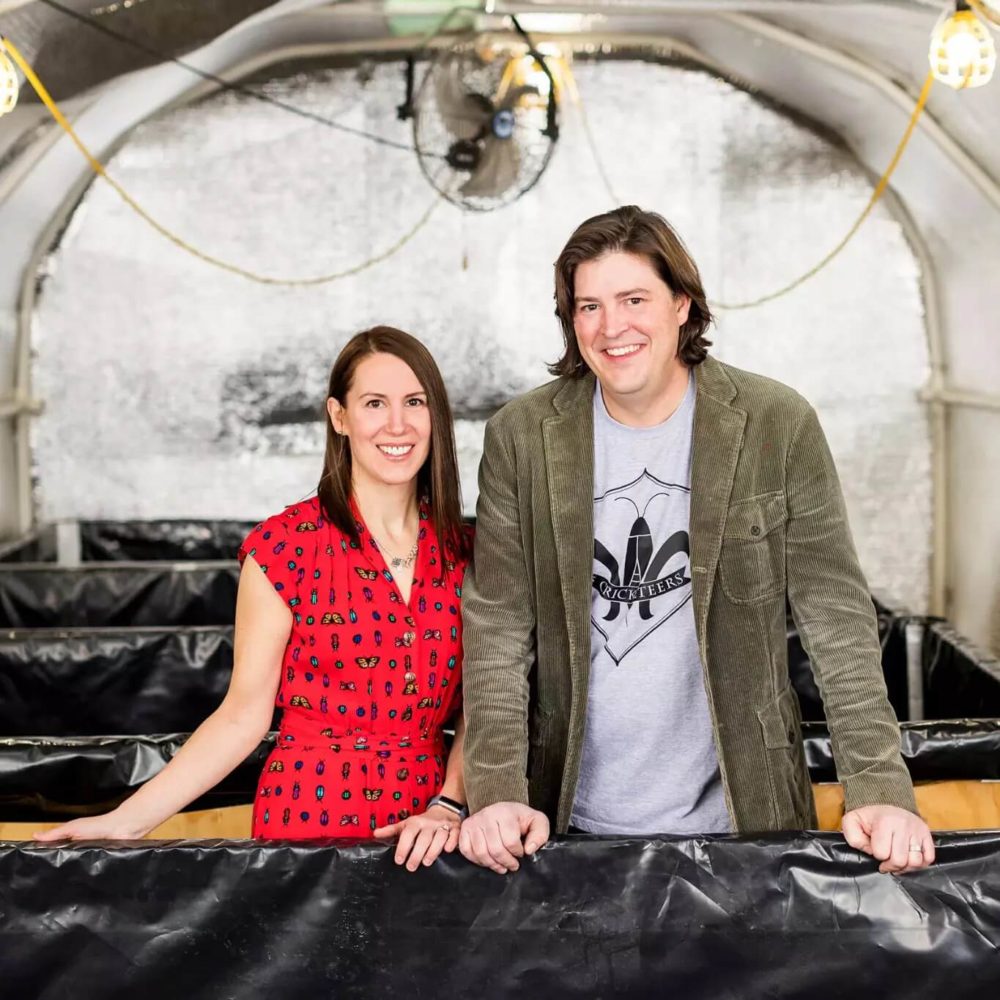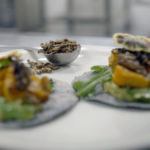
Did you know that crickets are considered a “perfect” protein — and that eating insects could help save the planet? We talk to Claire Simons of 3 Cricketeers, a Minneapolis cricket farm that supplies edible insects to restaurants, food companies and consumers. While there is still an “ick factor,” Claire says more people are interested in trying crickets, which can be raised far more sustainably than other sources of protein, particularly beef. Not only do cricket farms require a fraction of the land, feed and water, but the insects themselves emit virtually no greenhouse gas, a big contributor to climate change. In this podcast episode, hosts Colleen DeBaise and Sue Williams sample chocolate-covered crickets and interview Claire about her inspiring startup story.
And we mentioned our beer podcast a few times in this episode. Give it a listen here.
COLLEEN: Welcome to The Story Exchange. I'm Colleen DeBaise.
SUE: And I'm Sue Williams.
COLLEEN: And because we'll do anything in the name of good journalism…
SUE: On our last podcast we “tried” beer…
COLLEEN: …today we're trying edible insects. Before I try this chocolate-covered cricket, I am going to remind myself that millions of people around the world eat bugs as part of their diet.
SUE: I am not bothered by crickets, but I am going to remind myself how good this is for the environment!
COLLEEN: So these cricket products — which are considered a perfect protein — are made by a family business in Minneapolis.
CLAIRE: My name is Claire Simons. I am a co-founder and co-owner of 3 Cricketeers Cricket Farm.
SUE: We visited Claire last fall at her 3,500-square-foot indoor facility, filled with rows and rows of breeding crickets.
SUE (FROM BROLL): How old are these crickets?
CLAIRE (FROM BROLL): They're about 8 weeks. They're full-grown.
SUE: Claire and her husband Chad were inspired to start 3 Cricketeers back in 2015.
CLAIRE: So our son came home on Earth Day with a cricket-flour cookie from school and said, "You'll never believe what I ate." And it was a snickerdoodle. And it was delicious.
COLLEEN: So, that was a very cinnamon-y cricket experience.
SUE: Yes. You can eat crickets in many different ways.
CLAIRE: In the kitchen we dehydrate the crickets and process them. I mill them into a fine powder and we make cookies with that, we make crisps with that, or we season them and roast them whole and make them into snack mixes or cover them in chocolate.
COLLEEN: So, back to that fateful day that their son brought the cricket treat home from school.
CLAIRE: Chad had been talking about bugs.
COLLEEN: He's an environmental lawyer, concerned about climate change.
CLAIRE: We definitely always had discussions about, there's not going to be enough water, and there's not going to be enough land. We're just not doing things sustainably.
SUE: Claire, meanwhile, is a maternity nurse.
CLAIRE: I work locally at M Health Fairview on the Family Care Center floor.
SUE: But the two just realized, in that snickerdoodle moment, that they could join forces and do their part to help the earth.
CLAIRE: We both looked at each other and said, "Oh my gosh." So we, the next day, built a habitat downstairs in the basement, next to the washer and dryer. We had a little humidifier and set up a little heater and bought some crickets.
COLLEEN: Within just a year or two…
CLAIRE: …we rented a space and built thermal tents and kept building the population.
SUE: As they learned to breed crickets, they would sell live ones to pet shops to generate revenue.
COLLEEN: By 2021 they were making $200,000 dollars in annual sales and focusing more on the edible side of the business.
CLAIRE: So we decided after we moved in here and had our set up going that we would build a commercial kitchen.
SUE: Claire showed us how she prepares the crickets for some of their recipes. The day we were visiting, she was covering them with a thick spicy sauce and roasting them on giant trays to make a crunchy snack that actually would have gone well with our beers last time.
CLAIRE (FROM BROLL): It kind of looks like ground beef.
SUE: And we also got a tour of the incubator, where baby crickets were hatching.
CLAIRE (FROM BROLL): This is where we collect the eggs from the female crickets.
SUE: Their son Maddox now works with them.
CLAIRE (FROM BROLL): They lay them in the peat moss. So, Maddox collected them and now he's moistening them so that they stay in the incubator, they don't dry out. And so he's just kind of covering them with water.
COLLEEN: We have a video about the 3 Cricketeers on our site, which you can check out. And I love how Claire, a maternity nurse by training, very proudly holds out a container of baby crickets poking their heads out of the moss.
CLAIRE (FROM BROLL): You can see a lot of them that have just hatched. But these are little just hatched baby Pinhead crickets.
SUE (FROM TAPE): So let's get into the amount of energy and resources you need to raise crickets in comparison, say to dairy, beef. Let's talk a little bit about that.
CLAIRE: For crickets, obviously, it's a fraction of the land, feed, water, than it would for other sources of protein or beef. For water, cattle, I believe it's about 10,000 gallons per pound, and crickets it's one. And crickets emit virtually no greenhouse gas.
SUE: And compared to, say, what happens with large animals, in terms of slaughtering, it's a much gentler process with crickets. Chad showed us how he puts them in the walk-in freezer…
CHAD: What we call the Iron Maiden. They fall asleep in about a half an hour; they go into a hibernation, and we leave them in overnight before we harvest them. So they're frozen solid, then we rinse them off and then Claire takes them.
CLAIRE: And I take them into the kitchen.
COLLEEN: It's amazing, the nutritional benefits of crickets. If you need some convincing, here's an environmental scientist at the University of Wisconsin, Valerie Stull.
VALERIE STULL: Edible insects are an excellent source of protein and most contain all essential amino acids for human nutrition. They're also very rich in minerals like calcium, iron and zinc. Some edible insects have a lot of B vitamins including B12, riboflavin and folic acid. Insects are also high in healthy polyunsaturated fatty acids, the good ones, as well as having fiber, which most other animal products don't have in them.
SUE: But persuading people to eat crickets on a regular basis has certainly been one of 3 Cricketeers’s biggest challenges — here's Claire again.
CLAIRE: I think the ick factor is definitely there. We in our culture look at a bug as a pest, and it's a preconceived notion. You just think it's dirty. You think it's something that we shouldn't be eating.
SUE: Claire and Chad have tried a few different strategies.
CLAIRE: At first, we really thought, “Maybe people will want to buy them frozen raw next to the shrimp,” and that didn't happen.
SUE: Next they tried cricket flour — which certainly seems more palatable. You're not looking at cricket legs or eyes.
COLLEEN: And it can be sold to chefs or restaurants or food producers.
SUE: But even that is a challenge.
CLAIRE: People don't know what to do with this. The education piece really has to come first.
GUSTAVO ROMERO: OK, so we're going to make some cricket tortillas. We're going to incorporate a little bit of cricket powder.
COLLEEN: That is Gustavo Romero, a local chef who Claire and Chad have brought on as sort of an education consultant, to show how whole crickets or cricket flour can be used in recipes. They'll do cooking demonstrations at places like the Minnesota State Fair.
GUSTAVO: When you understand the flavors, you really appreciate that, I think. And for me it might be even a little nostalgic, when I'm able to take something that I grew up eating.
SUE: So Gustavo made us tortillas using a generous bit of cricket flour, and he topped them with soft winter squash and avocado and an amazing sauce with chilis, peanuts, and garlic — and whole roasted crickets, of course. It was totally delicious.
COLLEEN: And we caught up with Claire recently, to see how sales are going…and things are going well. But it turns out that it's those novelty products — crickets dipped in chocolate, or rolled in spices, that are currently selling the best.
SUE: She hopes people will try a cricket on a dare — but then get hooked on the benefits.
CLAIRE: Right now we're going after the novelty side. I think it's going to be a novelty in this country for a while, so, that's not going to go away.
SUE: 3 Cricketeers recently worked with a marketing consultant and rolled out new, bright-green packaging, featuring a giant, bug-eyed cartoon cricket — just in case you forgot what you were eating — to play up the "crickets as food" aspect.
COLLEEN: This summer, a popular Youtube channel called Snake Discovery, about misunderstood animals, stopped by — here's a clip.
SNAKE DISCOVERY: Today we're at 3 Cricketeers in Minnesota, and we're going to learn all about cricket farming.
SUE: The hosts of the show tried the cricket snacks…
SNAKE DISCOVERY: Oh, those are really good! Are they spicy? I know I'm a big wimp.
COLLEEN: Claire told me sales spiked after this video aired, as people were tempted to try the crickets.
CLAIRE: I think with the pandemic, with people being home, putting their health at foremost and seeing climate change in their face, they are waking up to the fact that we cannot continue on with what we're doing. So I think they're open to it. Now they want to try it. They're not scared.
SUE: Next up for 3 Cricketeers is working with its trade group…
COLLEEN: …which is the North American Coalition for Insect Agriculture…
SUE: …to get the FDA to formally regulate insects as human food — that would help normalize the eating of crickets.
CLAIRE: We're hoping that it's going to be sooner than later.
COLLEEN: Like many people, Claire believes that crickets — which have been eaten for centuries all around the world — are the food of the future.
CLAIRE: Raising crickets for human consumption is not the answer, but it's a piece of the puzzle. We can be an example for people that this is a way to do something about it and to bring about this change that's very much needed.
COLLEEN: We thank Claire for sharing the 3 Cricketeers's story.
SUE: And we thank you for listening.


